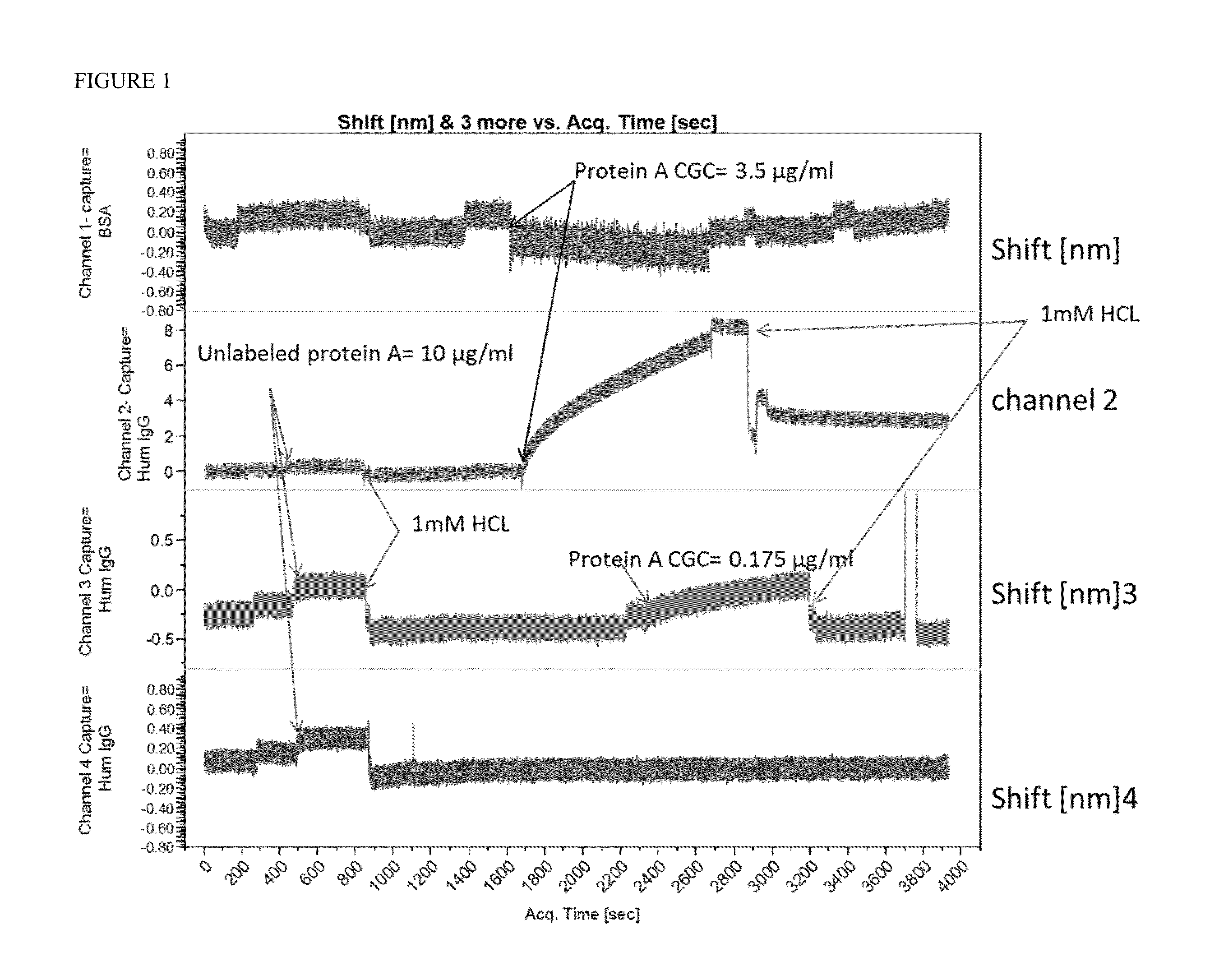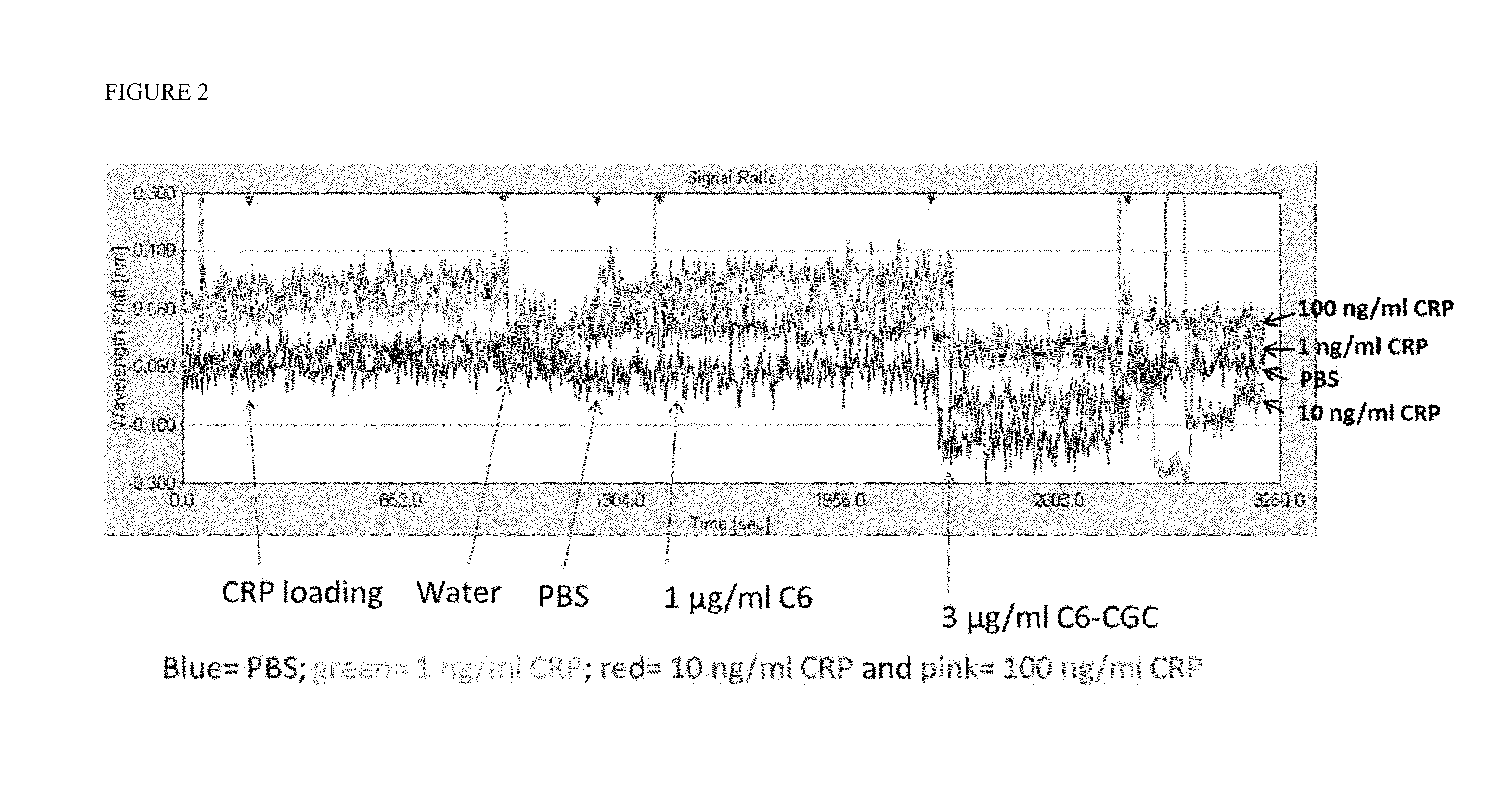Signal amplification in plasmonic specific-binding partner assays
- Summary
- Abstract
- Description
- Claims
- Application Information
AI Technical Summary
Benefits of technology
Problems solved by technology
Method used
Image
Examples
example 1
Amplification of LSPR Signals with Gold Nanoparticle-Conjugated Analyte
[0078]An analyte detection system was prepared by providing a plastic chip on which was deposited a gold nanolayer film. Human IgG proteins (100 μg / ml) were immobilized to the gold nanolayer film to create the sensor surface. A control sensor was constructed by immobilizing bovine serum albumin to the gold nanolayer film. The two types of sensor surfaces were positioned within an instrument equipped with light emitting and light collecting fibers that shine light on the gold nanolayer surface and collect the light reflected back from the surface.
[0079]A sample containing free protein A (10 μg / ml) was contacted with the two types of sensor surfaces and the changes in the reflectance spectra were measured. As shown in FIG. 1, introduction of free protein A to the sensor containing immobilized human IgG does not produce a significant visible change in the reflectance spectrum of the gold nanolayer film as measured b...
example 2
Amplification of LSPR Signals in a Sandwich Assay
[0082]This example describes a series of experiments designed to evaluate whether amplification of localized surface plasmon resonance signals with gold nanoparticle conjugates could also be achieved in a sandwich assay format in which the target analyte is not directly conjugated to the gold nanoparticles. A gold nanolayer chip surface was prepared as described in Example 1. The C7 antibody against C-reactive protein (CRP) (100 μg / ml) was immobilized to the gold nanolayer film deposited on the chip surface to create the anti-CRP sensor. The C6 antibody, which recognizes a distinct, non-overlapping epitope of CRP than the C7 antibody, was conjugated to colloidal gold nanoparticles (C6-CGC) for some experiments or used in an unlabeled form for other experiments.
[0083]In a first series of experiments, a sample containing one of three different concentrations of CRP (1 ng / ml, 10 ng / ml, or 100 ng / ml) was incubated with the anti-CRP sensor...
example 3
Enhanced Signal Amplification with Gold-Coated Silver Nanostructures
[0087]To examine whether varying the type of metal used to label the binding partners affected the amplification of LSPR signals, composite metal nanostructures were prepared. Specifically, gold-coated silver nanostructures were prepared as follows. Silver nanostructures were prepared by adding 50.0 mL of deionized H2O, 500.0 μL Trisodium Citrate (75 mM), 200 μL AgNO3 (200 mM), and 500.0 μL H2O2 (27%) while stirring vigorously at room temperature. A 500 μL aliquot of NaBH4 (200 mM) was then rapidly injected into the aqueous solution causing a color change to light yellow. Over a period of several minutes the color continued to change from dark yellow to red to purple and finally stabilizing at blue. The UV / Vis spectra determined the peak absorbance of the solution to be at 604.5 nm.
[0088]A gold coating was added to the silver nanostructures by adding 5.0 mL of the blue solution to a mixture of 50 μL of Polyvinylpyrr...
PUM
 Login to View More
Login to View More Abstract
Description
Claims
Application Information
 Login to View More
Login to View More - R&D
- Intellectual Property
- Life Sciences
- Materials
- Tech Scout
- Unparalleled Data Quality
- Higher Quality Content
- 60% Fewer Hallucinations
Browse by: Latest US Patents, China's latest patents, Technical Efficacy Thesaurus, Application Domain, Technology Topic, Popular Technical Reports.
© 2025 PatSnap. All rights reserved.Legal|Privacy policy|Modern Slavery Act Transparency Statement|Sitemap|About US| Contact US: help@patsnap.com



